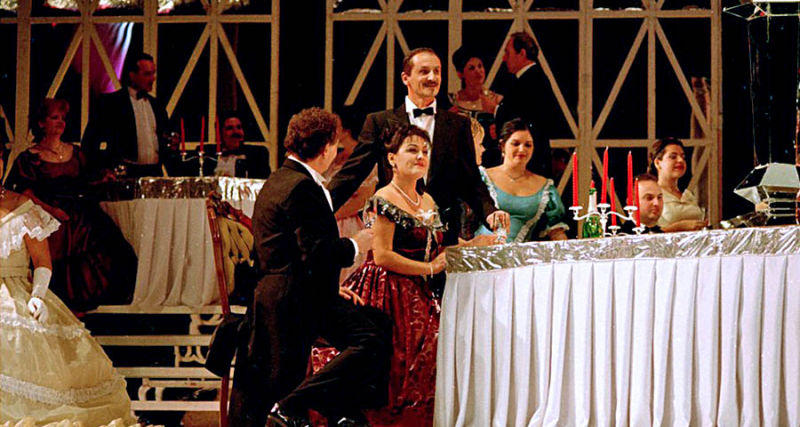











La traviata è una delle opere più famose, di Giuseppe Verdi. Scritta su libretto di Francesco Maria Piave, si compone di tre atti ed è tratto dalla rappresentazione teatrale “La signora delle camelie - La dame aux camélias”, scritta dall’autore francese Alexandre Dumas (figlio); quest’opera verdiana, assieme a “Il trovatore” e a “Rigoletto“, fa parte della cosiddetta “trilogia popolare”. La prima rappresentazione fu al "Teatro La Fenice" di Venezia il 6 Marzo 1853. L’idea della Traviata viene a Giuseppe Verdi , dopo le prime rappresentazioni teatrali della "Dame aux camélias" nel febbraio 1852. Il dramma era strato ricavato, dall’autore Alexandre Dumas, da un proprio romanzo autobiografico del 1848 che era stato un bestseller della letteratura scandalistica del tempo. La scabrosità del soggetto, la parabola amorosa di Alphonsine Duplessis, una delle più celebri cortigiane parigine, morta ventitreenne appena un anno prima dell’uscita del romanzo, aveva colpito Verdi. Musicalmente nella Traviata fuori luogo l'utilizzo del valzer, ballo che stava conquistando l’Europa ai tempi di Verdi, mentre il dramma era ambientato nel secolo precedente. Infatti a causa della forte critica alla società borghese del tempo, l'opera, nei teatri di Firenze, Bologna, Parma, Napoli e Roma, fu rimaneggiata dalla censura e messa in scena con alcuni pezzi totalmente stravolti e per la stessa ragione (sfuggire alla censura), la Traviata dovette essere spostata come ambientazione cronologica dal XIX secolo al XVIII secolo, trasformando, un melodramma cronachistico in una tragedia storica e stemperando la provocazione insita nell’additare i contemporanei e la loro falsa e cinica morale come i veri responsabili della triste fine di Violetta(Margherita in Dumas). La Traviata Giuseppe Verdi la scrisse in 40 giorni, da fine gennaio ai primi di marzo del 1853. Fu un totale insuccesso, e come disse lo stesso Maestro “un fiasco“. Il Maestro Verdi sostenne ripetutamente (come aveva già detto prima del debutto), che lo scarso entusiasmo del pubblico non era imputabile alla musica, ma ai cantanti, reputati non altezza sia vocalmente che fisicamente. In rotta con l'amministrazione del Teatro La Fenice, colpevole di non aver accolto le sue critiche sulla scelta degli artisti, Verdi decise di non autorizzare altre messe in scena de "La Traviata" fino a quando i panni di Violetta, Alfredo e Giorgio Germont non fossero stati indossati da artisti adeguati ai ruoli. In una sua corrispondenza con casa Ricordi si legge “non indaghiamo sulle cause, la storia è così. Colpa mia o dei cantanti? … Il tempo giudicherà“. Effettivamente Verdi conosceva e sapeva quello che scriveva, attese sino alla sera del 15 maggio 1854, quattordici mesi dopo l’insuccesso alla Fenice, e sempre a Venezia, pero al teatro San Benedetto i veneziani, ne decretò il successo, ottenendo un trionfo ed un ampio consenso di stampa.
Le più belle arie : Libiamo ne’ lieti calici: Libiamo ne’ lieti calici - Un dì felice, eterea - Amami Alfredo - Noi siamo zingarelle, È Piquillo un bel gagliardo.
La Traviata is one of the most famous works by Giuseppe Verdi. Written on a libretto by Francesco Maria Piave, it consists of three acts and is drawn from the theatrical representation "The Lady of the Camellias-La Dame aux Camélias", written by the French author Alexandre Dumas (son); This Verdi opera, together with "Il Trovatore" and "Rigoletto", is part of the so-called "popular trilogy". The first performance was at the "Teatro La Fenice" in Venice on March 6, 1853. The idea of Traviata comes to Giuseppe Verdi, after the first theatrical performances of the "Dame aux camélias" in February 1852.The drama was the layer obtained, by the author Alexandre Dumas, from his own autobiographical novel of the 1848 which had been a bestseller of the tabloid literature of the time. The roughness of the subject, the amorous parable of Alphonsine Duplessis, one of the most famous Parisian courtiers, died old just a year before the release of the novel, had struck Verdi. Musically in the Traviata out of place the use of the waltz, a dance that was conquering Europe in the days of Verdi, while the drama was set in the previous century. Because of the strong criticism of the bourgeois society of the time, the work, in the theatres of Florence, Bologna, Parma, Naples and Rome, it was remodeled by censorship and staging with some pieces totally overturned and for the same reason (escaping censorship), La Traviata had to be moved as a chronological setting from the XIX century to the XVIII century, by transforming, in this way, a melodrama chronicle in a historical tragedy and blurring the provocation inherent in pointing to the contemporaries and their false and cynical morals as the true leaders of the sad end of Violetta (Margaret in Dumas). La Traviata Giuseppe Verdi wrote it in 40 days, from late January to early March of 1853. It was a total failure, and as the master himself said, "a fiasco."
The Maestro Verdi sustained repeatedly (as he had already said before the debut), that the lack of enthusiasm of the public was not attributable to the music, but to the singers, reputed not height both vocally and physically. En route with the administration of the Teatro La Fenice, guilty of not accepting his criticism of the choice of artists, Verdi decided not to authorise other staging of "La Traviata" until the role of Violetta, Alfredo and Giorgio Germont were not worn by artists adapted to the roles. In his correspondence with Casa Ricordi you read "not investigate on the causes, the story is so. My fault or the singers? ... Time would judge. " Verdi actually knew and knew what he wrote, waited until the evening of May 15, 1854, fourteen months after the failure at the Fenice, and always in Venice, Pero at the Teatro San Benedetto i Veneziani, decreed the success, obtaining a triumph and a wide consensus of printing.
One of the most beautiful airs: Libyan and happy chalices: Libyans and happy chalices-a joyful, ethereal-Love me Alfredo-we are Gypsies, it is Piquillo a beautiful.